tow DODGE NEON 2005 2.G Owner's Guide
[x] Cancel search | Manufacturer: DODGE, Model Year: 2005, Model line: NEON, Model: DODGE NEON 2005 2.GPages: 246, PDF Size: 3.69 MB
Page 166 of 246

ONBOARD DIAGNOSTIC SYSTEM Ð OBD II
Your vehicle is equipped with a sophisticated onboard
diagnostic system called OBD II. This system monitors
the performance of the emissions, engine, and automatic
transmission control systems. When these systems are
operating properly, your vehicle will provide excellent
performance and fuel economy, as well as engine emis-
sions well within current government regulations.
If any of these systems require service, the OBD II system
will turn on the ªMalfunction Indicator Light.º It will
also store diagnostic codes and other information to
assist your service technician in making repairs. Al-
though your vehicle will usually be drivable and not
need towing, see your dealer for service as soon as
possible.CAUTION!
²Prolonged driving with the ªMalfunction Indica-
tor Lightº on could cause further damage to the
emission control system. It could also affect fuel
economy and driveability. The vehicle must be
serviced before any emissions tests can be per-
formed.
²If the ªMalfunction Indicator Lightº is flashing
while the engine is running, severe catalytic con-
verter damage and power loss will soon occur.
Immediate service is required.
166 MAINTAINING YOUR VEHICLE
Page 171 of 246
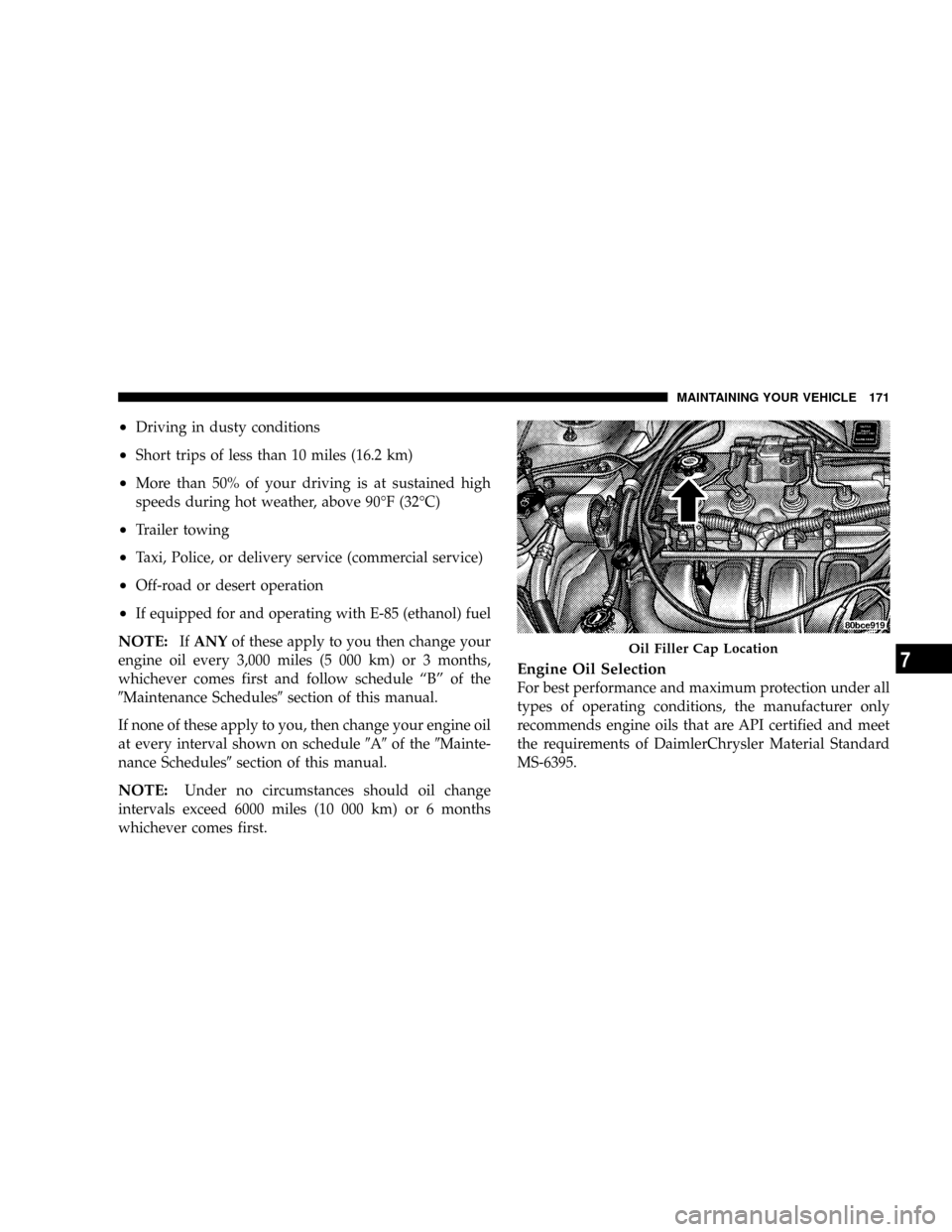
²Driving in dusty conditions
²Short trips of less than 10 miles (16.2 km)
²More than 50% of your driving is at sustained high
speeds during hot weather, above 90ÉF (32ÉC)
²Trailer towing
²Taxi, Police, or delivery service (commercial service)
²Off-road or desert operation
²If equipped for and operating with E-85 (ethanol) fuel
NOTE:IfANYof these apply to you then change your
engine oil every 3,000 miles (5 000 km) or 3 months,
whichever comes first and follow schedule ªBº of the
9Maintenance Schedules9section of this manual.
If none of these apply to you, then change your engine oil
at every interval shown on schedule9A9of the9Mainte-
nance Schedules9section of this manual.
NOTE:Under no circumstances should oil change
intervals exceed 6000 miles (10 000 km) or 6 months
whichever comes first.
Engine Oil Selection
For best performance and maximum protection under all
types of operating conditions, the manufacturer only
recommends engine oils that are API certified and meet
the requirements of DaimlerChrysler Material Standard
MS-6395.
Oil Filler Cap Location
MAINTAINING YOUR VEHICLE 171
7
Page 174 of 246

CAUTION!
Damage to the catalytic converter can result if your
vehicle is not kept in proper operating condition. In
the event of engine malfunction, particularly involv-
ing engine misfire or other apparent loss of perfor-
mance, have your vehicle serviced promptly. Contin-
ued operation of your vehicle with a severe
malfunction could cause the converter to overheat,
resulting in possible damage to the converter and the
vehicle.
WARNING!
A hot exhaust system can start a fire if you park over
materials that can burn. Such materials might be
grass or leaves coming into contact with your ex-
haust system. Do not park or operate your vehicle in
areas where your exhaust system can contact any-
thing that can burn.
In unusual situations involving grossly malfunctioning
engine operation, a scorching odor may suggest severe
and abnormal catalyst overheating. If this occurs, stop
the vehicle, turn off the engine and allow it to cool.
Service, including a tune up to manufacturers specifica-
tions, should be obtained immediately.
To minimize the possibility of catalyst damage:
²Do not shut off the engine or interrupt the ignition
when the transaxle is in gear and the vehicle is in
motion.
²Do not try to start the engine by pushing or towing the
vehicle.
²Do not idle the engine with any spark plug wires
disconnected for prolonged period.
Engine Timing Belt
Replace the engine timing belt at the intervals described
in the appropriate maintenance schedule.
174 MAINTAINING YOUR VEHICLE
Page 190 of 246
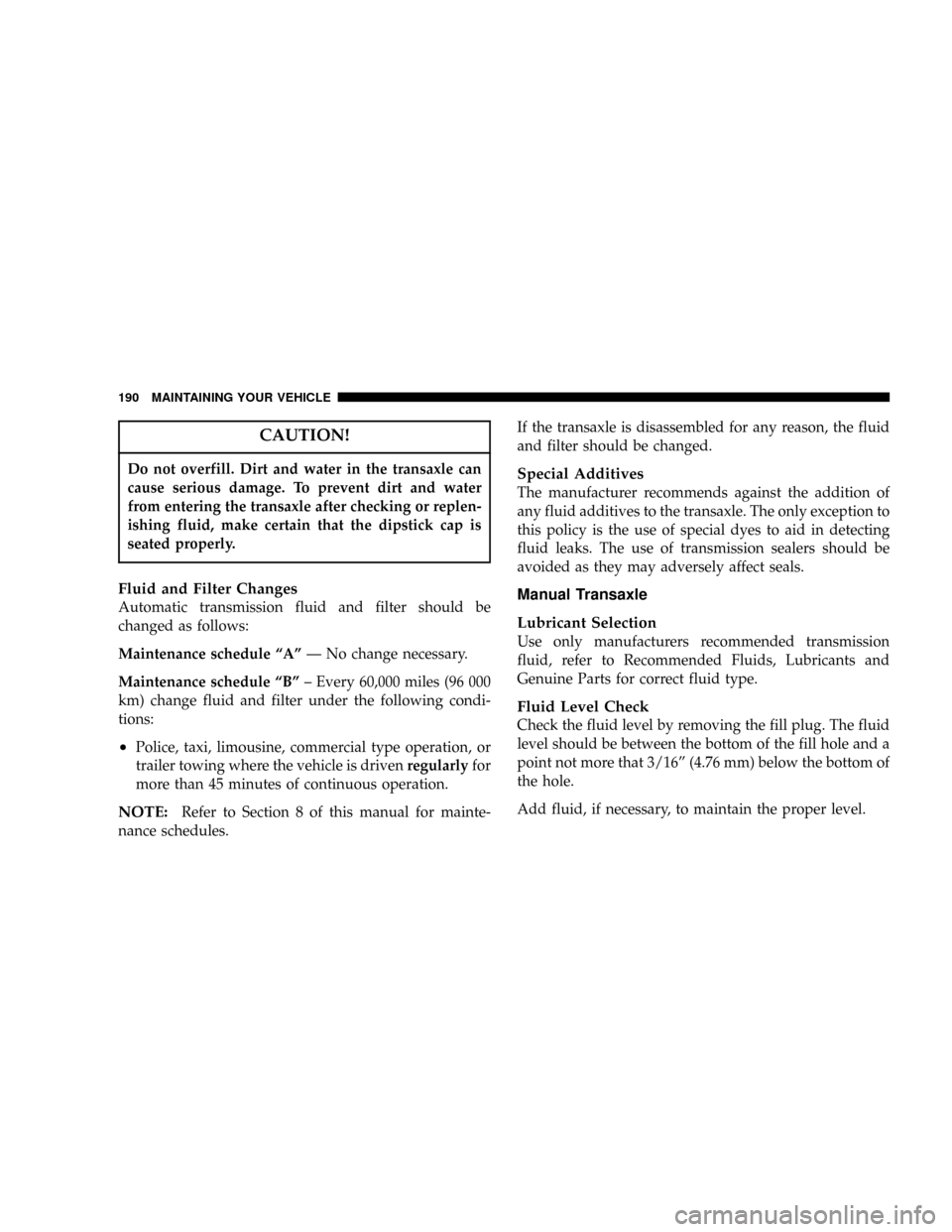
CAUTION!
Do not overfill. Dirt and water in the transaxle can
cause serious damage. To prevent dirt and water
from entering the transaxle after checking or replen-
ishing fluid, make certain that the dipstick cap is
seated properly.
Fluid and Filter Changes
Automatic transmission fluid and filter should be
changed as follows:
Maintenance schedule ªAºÐ No change necessary.
Maintenance schedule ªBº± Every 60,000 miles (96 000
km) change fluid and filter under the following condi-
tions:
²Police, taxi, limousine, commercial type operation, or
trailer towing where the vehicle is drivenregularlyfor
more than 45 minutes of continuous operation.
NOTE:Refer to Section 8 of this manual for mainte-
nance schedules.If the transaxle is disassembled for any reason, the fluid
and filter should be changed.
Special Additives
The manufacturer recommends against the addition of
any fluid additives to the transaxle. The only exception to
this policy is the use of special dyes to aid in detecting
fluid leaks. The use of transmission sealers should be
avoided as they may adversely affect seals.
Manual Transaxle
Lubricant Selection
Use only manufacturers recommended transmission
fluid, refer to Recommended Fluids, Lubricants and
Genuine Parts for correct fluid type.
Fluid Level Check
Check the fluid level by removing the fill plug. The fluid
level should be between the bottom of the fill hole and a
point not more that 3/16º (4.76 mm) below the bottom of
the hole.
Add fluid, if necessary, to maintain the proper level.
190 MAINTAINING YOUR VEHICLE
Page 206 of 246
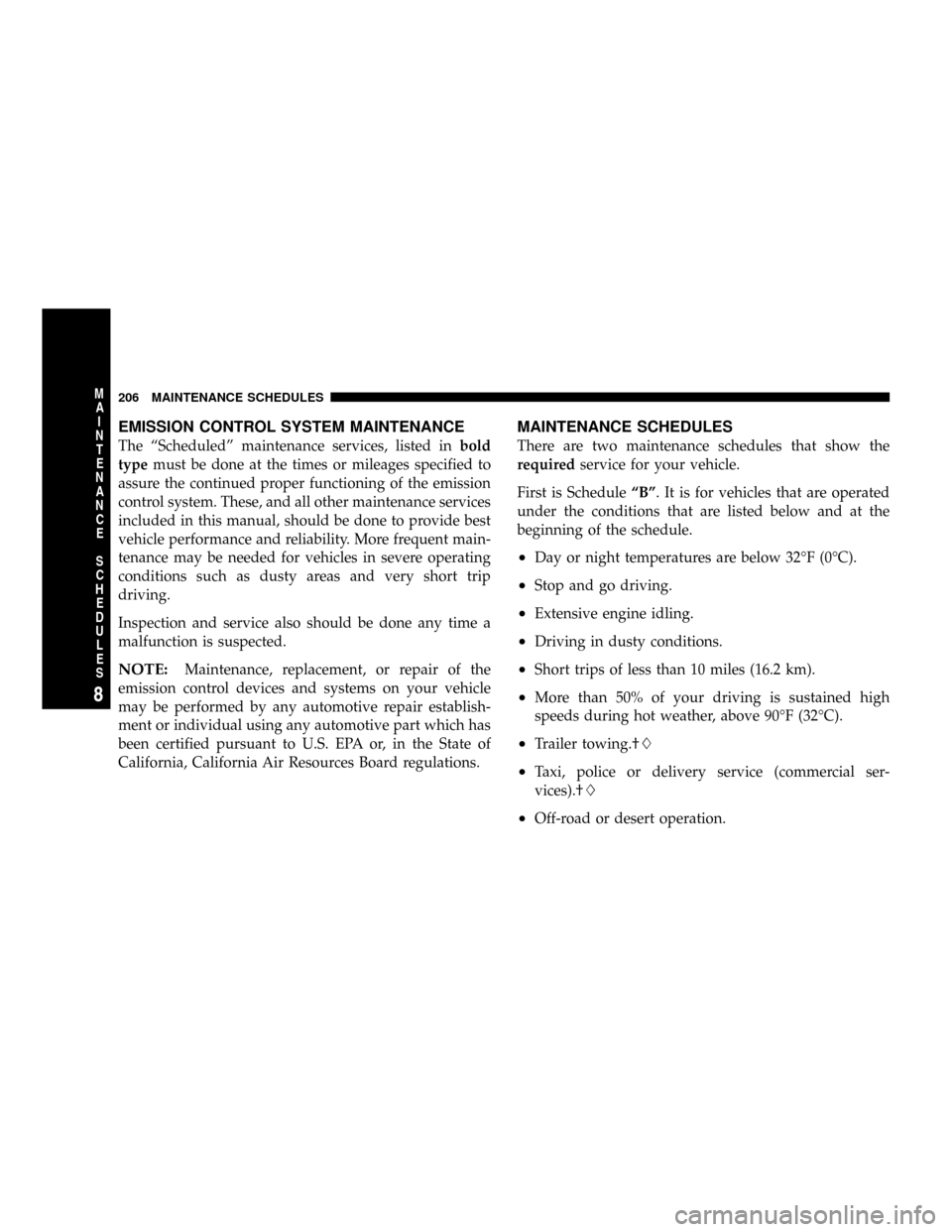
EMISSION CONTROL SYSTEM MAINTENANCE
The ªScheduledº maintenance services, listed inbold
typemust be done at the times or mileages specified to
assure the continued proper functioning of the emission
control system. These, and all other maintenance services
included in this manual, should be done to provide best
vehicle performance and reliability. More frequent main-
tenance may be needed for vehicles in severe operating
conditions such as dusty areas and very short trip
driving.
Inspection and service also should be done any time a
malfunction is suspected.
NOTE:Maintenance, replacement, or repair of the
emission control devices and systems on your vehicle
may be performed by any automotive repair establish-
ment or individual using any automotive part which has
been certified pursuant to U.S. EPA or, in the State of
California, California Air Resources Board regulations.
MAINTENANCE SCHEDULES
There are two maintenance schedules that show the
requiredservice for your vehicle.
First is ScheduleªBº. It is for vehicles that are operated
under the conditions that are listed below and at the
beginning of the schedule.
²Day or night temperatures are below 32ÉF (0ÉC).
²Stop and go driving.
²Extensive engine idling.
²Driving in dusty conditions.
²Short trips of less than 10 miles (16.2 km).
²More than 50% of your driving is sustained high
speeds during hot weather, above 90ÉF (32ÉC).
²Trailer towing.²L
²Taxi, police or delivery service (commercial ser-
vices).²L
²Off-road or desert operation.
206 MAINTENANCE SCHEDULES
8
M
A
I
N
T
E
N
A
N
C
E
S
C
H
E
D
U
L
E
S
Page 209 of 246
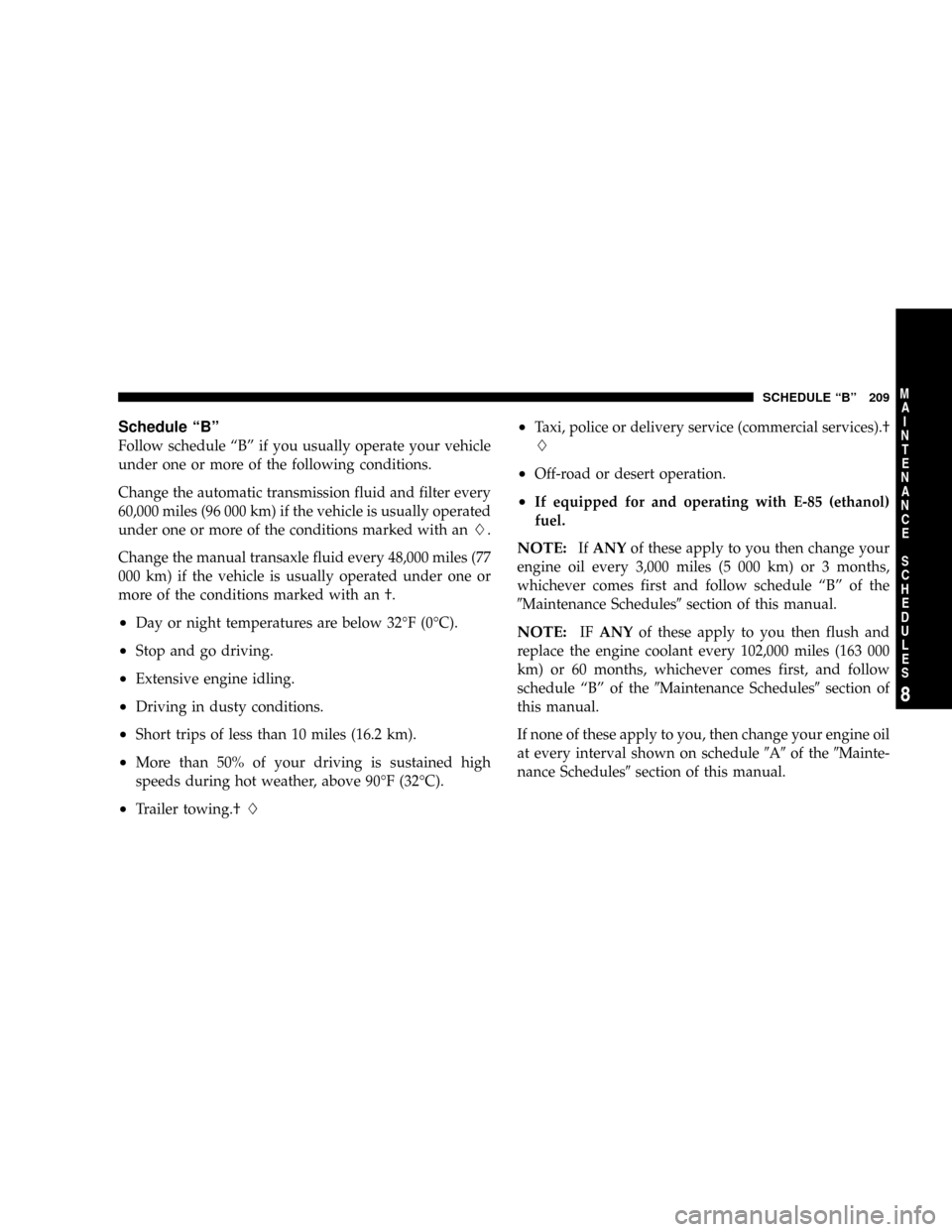
Schedule ªBº
Follow schedule ªBº if you usually operate your vehicle
under one or more of the following conditions.
Change the automatic transmission fluid and filter every
60,000 miles (96 000 km) if the vehicle is usually operated
under one or more of the conditions marked with anL.
Change the manual transaxle fluid every 48,000 miles (77
000 km) if the vehicle is usually operated under one or
more of the conditions marked with an ².
²Day or night temperatures are below 32ÉF (0ÉC).
²Stop and go driving.
²Extensive engine idling.
²Driving in dusty conditions.
²Short trips of less than 10 miles (16.2 km).
²More than 50% of your driving is sustained high
speeds during hot weather, above 90ÉF (32ÉC).
²Trailer towing.²L
²Taxi, police or delivery service (commercial services).²
L
²Off-road or desert operation.
²If equipped for and operating with E-85 (ethanol)
fuel.
NOTE:IfANYof these apply to you then change your
engine oil every 3,000 miles (5 000 km) or 3 months,
whichever comes first and follow schedule ªBº of the
9Maintenance Schedules9section of this manual.
NOTE:IFANYof these apply to you then flush and
replace the engine coolant every 102,000 miles (163 000
km) or 60 months, whichever comes first, and follow
schedule ªBº of the9Maintenance Schedules9section of
this manual.
If none of these apply to you, then change your engine oil
at every interval shown on schedule9A9of the9Mainte-
nance Schedules9section of this manual.
SCHEDULE ªBº 209
8
M
A
I
N
T
E
N
A
N
C
E
S
C
H
E
D
U
L
E
S
Page 217 of 246
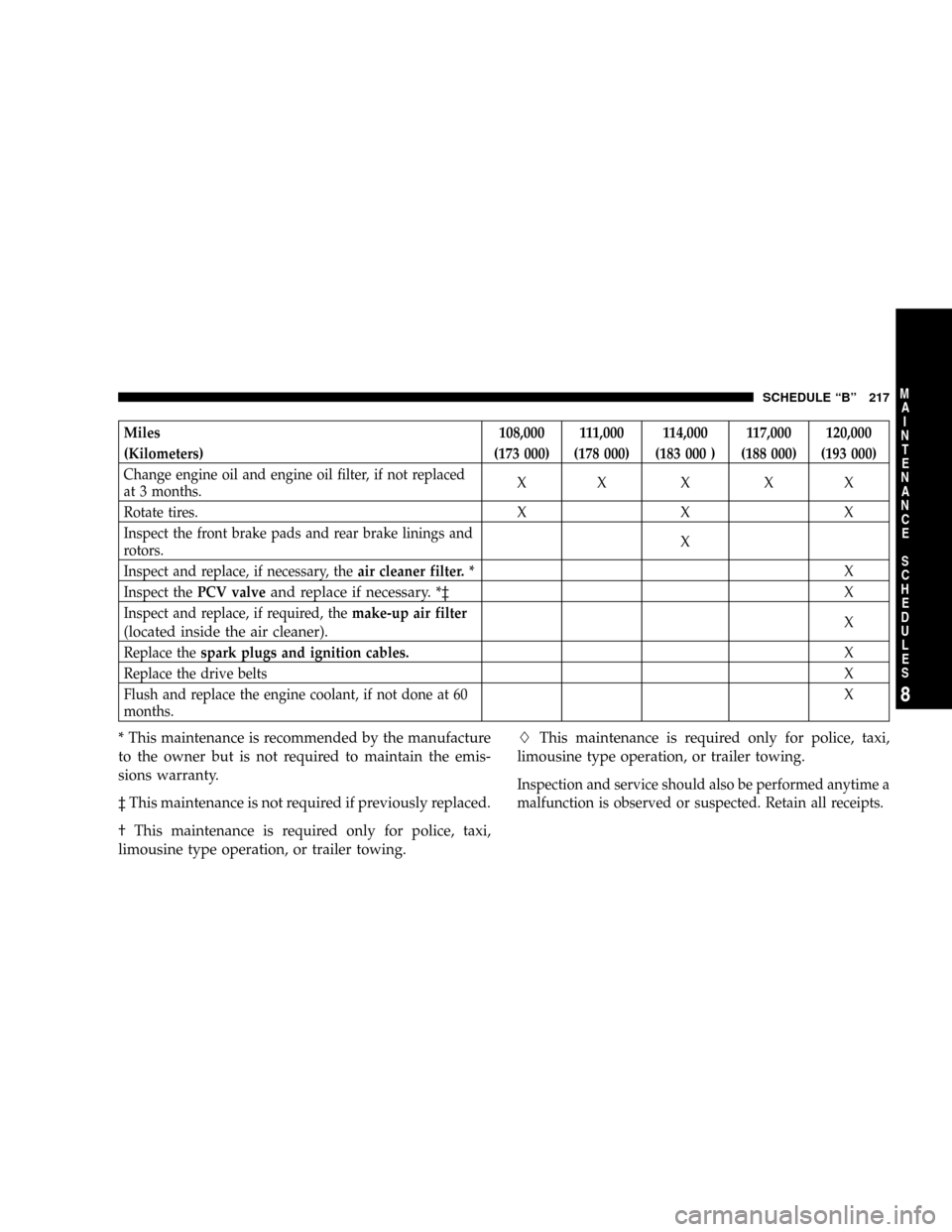
Miles 108,000 111,000 114,000 117,000 120,000
(Kilometers) (173 000) (178 000) (183 000 ) (188 000) (193 000)
Change engine oil and engine oil filter, if not replaced
at 3 months.XX X XX
Rotate tires. X X X
Inspect the front brake pads and rear brake linings and
rotors.X
Inspect and replace, if necessary, theair cleaner filter.
*X
Inspect thePCV valve
and replace if necessary. *³X
Inspect and replace, if required, themake-up air filter
(located inside the air cleaner).X
Replace thespark plugs and ignition cables.X
Replace the drive beltsX
Flush and replace the engine coolant, if not done at 60
months.X
* This maintenance is recommended by the manufacture
to the owner but is not required to maintain the emis-
sions warranty.
³ This maintenance is not required if previously replaced.
² This maintenance is required only for police, taxi,
limousine type operation, or trailer towing.LThis maintenance is required only for police, taxi,
limousine type operation, or trailer towing.
Inspection and service should also be performed anytime a
malfunction is observed or suspected. Retain all receipts.
SCHEDULE ªBº 217
8
M
A
I
N
T
E
N
A
N
C
E
S
C
H
E
D
U
L
E
S
Page 237 of 246

Emergency, In Case of
Jacking............................. 152
Jump Starting........................ 155
Towing............................. 160
Emergency Trunk Release................. 18
Emission Control System Maintenance....167,206
Engine............................... 165
Break-In Recommendations............... 46
Checking Oil Level.................... 169
Compartment........................ 165
Cooling............................ 181
Exhaust Gas Caution.................. 144
Jump Starting........................ 155
Oil ..........................169,202,203
Oil Change Interval................... 170
Oil Filler Cap........................ 172
Oil Filter............................ 203
Oil Selection......................... 171
Oil Synthetic......................... 172
Overheating......................... 150
Temperature Gauge.................... 81
Timing Belt.......................... 174
Exhaust Gas Caution..................46,144Exhaust Pipes......................... 180
Exhaust System........................ 180
Extender, Seat Belt....................... 31
Filters
Air Cleaner.......................... 175
Automatic Transaxle................... 190
Engine Fuel......................... 175
Engine Oil.......................173,203
Flashers
Hazard Warning...................... 150
Flooded Engine Starting.................. 115
Fluid, Brake........................... 203
Fluid Capacities........................ 202
Fluid Leaks............................ 47
Fluid Level Checks
Automatic Transaxle................... 188
Manual Transaxle..................... 190
Fluids............................... 203
Fog Lights...........................62,77
Folding Rear Seat....................... 57
Freeing A Stuck Vehicle.................. 159
Front Suspension Ball Joints............... 178
INDEX 237
10
Page 242 of 246

Rear Window Defroster.................. 110
Reclining Front Seats..................... 56
Recommended Fluids, Lubricants and Genuine
Parts............................... 203
Recreational Towing..................... 148
Reformulated Gasoline................... 142
Refrigerant............................ 177
Release, Hood.......................... 58
Remote Keyless Entry.................... 19
Remote Trunk Release.................... 18
Replacement Bulbs...................... 198
Replacement Keys....................... 12
Replacement Parts...................... 168
Replacement Tires...................... 138
Reporting Safety Defects................. 229
Rotation, Tires......................... 141
Safety Checks Inside Vehicle............... 47
Safety Checks Outside Vehicle.............. 47
Safety Defects, Reporting................. 229
Safety Information, Tire.................. 124
Safety Tips............................. 46
Satellite Radio.......................... 93Satellite Radio Antenna................... 96
Seat Belts.............................. 24
Adjustable Upper Shoulder Anchorage...... 28
And Pregnant Women.................. 30
Child Restraint........................ 39
Extender............................ 31
Front Seat............................ 24
Maintenance......................... 195
Rear Seat............................ 24
Untwisting Procedure................... 29
Seats................................. 55
Adjustment.......................... 55
Head Restraints....................... 57
Rear Folding......................... 57
Reclining............................ 56
Security Alarm (Theft Alarm).............22,79
Sentry Key.......................... 11,22
Sentry Key Programming.................. 12
Service Assistance...................... 224
Service Contract........................ 226
Service Manuals........................ 229
Setting the Clock........................ 82
Shift Speeds........................... 120
242 INDEX
Page 244 of 246

Load Capacity....................128,129
Quality Grading...................... 231
Radial............................. 135
Replacement......................... 138
Rotation............................ 141
Safety...........................124,132
Sizes............................... 125
Snow Tires.......................... 140
Spinning............................ 137
Tread Wear Indicators.................. 137
Towing
Disabled Vehicle...................... 160
Guide.............................. 147
Recreational......................... 148
Weight............................. 147
Trailer Towing......................... 146
Minimum Requirements................ 147
Trailer and Tongue Weight.............. 147
Warnings........................... 146
Trailer Towing Guide.................... 147
Trailer Weight......................... 147
Transaxle
Automatic................. 9,114,116,117,188Manual...................10,67,114,119,190
Overdrive........................... 118
Selection of Lubricant.................. 188
Transmitter Battery Service................ 21
Transporting Pets........................ 45
Tread Wear Indicators................... 137
Trip Odometer.......................... 80
Trip Odometer Reset Button................ 80
Trunk Release Button..................... 18
Trunk Release, Emergency................. 18
Trunk Release Remote Control.............. 18
Turn Signals.........................62,78
Underhood Fuses....................... 195
Uniform Tire Quality Grades.............. 231
Untwisting Procedure, Seat Belt............. 29
Vacuum/Vapor Harnesses................ 185
Variance, Compass....................... 53
Vehicle Identification Number............... 6
Vehicle Loading.....................129,146
Vehicle Modifications/Alterations............ 6
Vehicle Storage......................... 198
244 INDEX